
Owing to India's vastness and diversity, Indian music encompasses numerous genres in multiple varieties and forms which include classical music, folk, rock, and pop. It has a history spanning several millennia and developed over several geo-locations spanning the sub-continent. Music in India began as an integral part of socio-religious life.

Circle dance, or chain dance, is a style of social dance done in a circle, semicircle or a curved line to musical accompaniment, such as rhythm instruments and singing, and is a type of dance where anyone can join in without the need of partners. Unlike line dancing, circle dancers are in physical contact with each other; the connection is made by hand-to-hand, finger-to-finger or hands-on-shoulders, where they follow the leader around the dance floor. Ranging from gentle to energetic, the dance can be an uplifting group experience or part of a meditation.
The music of Iran encompasses music that is produced by Iranian artists. In addition to the traditional folk and classical genres, it also includes pop and internationally celebrated styles such as jazz, rock, and hip hop.

Sindhis are an Indo-Aryan ethnolinguistic group who speak the Sindhi language and are native to the Pakistani province of Sindh. The historical homeland of Sindhis is bordered by the southeastern part of Balochistan, the Bahawalpur region of Punjab and the Kutch region of Gujarat. Having been isolated throughout history unlike its neighbours, Sindhi culture has preserved its own uniqueness.
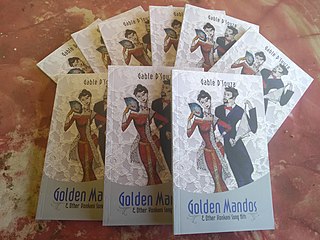
Music of Goa refers to music from the state of Goa, on the west coast of India. A wide variety of music genres are used in Goa ranging from Western art music to Indian classical music. Konkani music is also popular across this tiny state. Being a former territory of Portugal, Goa has a dominant western musical scene with the use of instrument such as the violin, drums, guitar, trumpet and piano. It has also produced a number of prominent musicians and singers for the world of Indian music. Portuguese Fado also has significance in Goa.

Dance in India comprises numerous styles of dances, generally classified as classical or folk. As with other aspects of Indian culture, different forms of dances originated in different parts of India, developed according to the local traditions and also imbibed elements from other parts of the country.

Nagas are various ethnic groups native to northeastern India and northwestern Myanmar. The groups have similar cultures and traditions, and form the majority of population in the Indian state of Nagaland and Naga Self-Administered Zone of Myanmar (Burma); with significant populations in Manipur, Arunachal Pradesh and Assam in India; Sagaing Region and Kachin State in Myanmar.
The Dhangars are a herding caste of people found in the Indian states of Maharashtra, Karnataka, Goa, Madhya Pradesh and Uttar Pradesh. They are referred as Gavli in southern Maharashtra, Goa and northern Karnataka, Golla in Andhra Pradesh and Karnataka and Ahir in northern Maharashtra. Some Gavlis live in forested hill tracts of India's Western Ghats. Gavli, also known as Dange or Mhaske, and Ahir are a sub-caste of Dhangar. However, there are many distinct Gavli castes in Maharashtra and Dhangar Gavli is one of them.
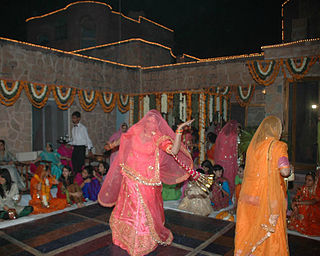
Ghoomar or ghumar is a traditional folk dance of Rajasthan. It was the Bhil tribe who performed it to worship Goddess Saraswati which was later embraced by other Rajasthani communities. The dance is chiefly performed by veiled women who wear flowing dresses called ghaghara. The dance typically involves performers pirouetting while moving in and out of a wide circle. The word ghoomna describes the twirling movement of the dancers and is the basis of the word ghoomar.
The Dances of Tripura refer to several forms of folk dance performed in the state of Tripura in northeastern India. These dances are performed by the Tripuri and Mog peoples, during annual regional celebrations, such as sowing and harvesting festivals.
Goan Catholics are an ethno-religious community of Indian Christians adhering to the Latin Rite of the Roman Catholic Church from the Goa state, in the southern part of the Konkan region along the west coast of India. They are Konkani people and speak the Konkani language.
Punjabi dances are an array of folk and religious dances of the Punjabi people indigenous to the Punjab region, straddling the border of India and Pakistan. The style of Punjabi dances ranges from very high energy to slow and reserved, and there are specific styles for men and women.

The Kalbelia are a snake charming tribe from the Thar Desert in Rajasthan, India. The dance is an integral part of their culture and performed by men and women.

Bhunjias, are an ethnic group found in India mainly reside in Sunabeda plateau in Odisha and Chhattisgarh. They are mostly found in Nuapada district, which is roughly between 22° 55′ N and 21° 30′ N latitude and 82° 35′ E longitude. It was a part of Khariar Zamindari, which formed the eastern and the southeastern region of Raipur district of Chhattisgarh division in Central Province till 1 April 1936, when it was transferred to Odisha on its creation. It is now in Komna block of Nuapada district in Orissa. In Chhattisgarh they are found in Raipur district.

Fugdi is a folk dance performed by the womenfolk of some communities of Konkanies in the Konkan coastal region of Goa and Maharashtra states during the Hindu religious festivals like Ganesh Chaturthi and Vrata or towards the end of other dances like Dhalo. According to certain historical facts, this dance style is said to have been created from few ancient Goan traditions. In addition, this dance is mainly performed during the Hindu month of Bhadrapada, when women usually take a break to escape boredom arising from their daily routines. Furthermore, it is also performed during religious and social events.
Kumar Suresh Singh (1935–2006) commonly known as K. S. Singh, was an Indian Administrative Service officer, who served as a Commissioner of Chhotanagpur (1978–80) and Director-General of the Anthropological Survey of India. He is known principally for his oversight and editorship of the People of India survey and for his studies of tribal history.
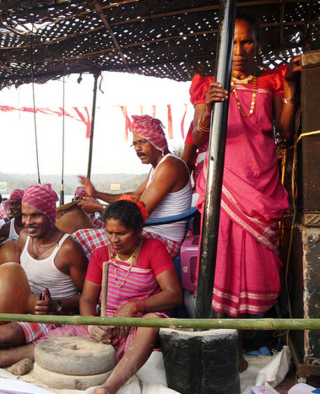
Gaudas and Kunbis are aboriginal people residing in the coastal Indian state of Goa. They are believed to be the original inhabitants of Konkan. Most follow folk Hinduism, but many were converted to Catholicism by the Portuguese missionaries during the Christianisation of Goa while still keeping their folk tradition and culture alive.
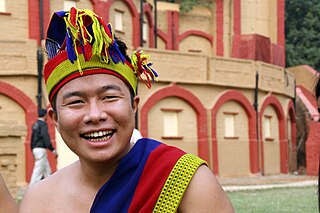
The Anāl is a Naga tribe native to Manipur state in North-East India and part of Myanmar. They are listed as a Scheduled Tribe, in accordance with The Scheduled Castes and Scheduled Tribes Orders (Amendment) Act, 1976 Indian Constitution. The Anāl tribe is one of the 'sixty six Naga tribes' of the Naga ancestral homeland. The members of this tribe are found both in India and Myanmar. In India, they are situated in the States of Manipur and Nagaland but mostly concentrated in the former. In the State of Manipur, the Anāl Naga population concentrated in Chandel and a few Anāl villages are located in its neighbouring districts, Churachandpur district has about three villages and Thoubal district has one or two.
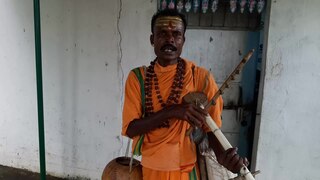
The Kendara is a wooden string instrument. The kendara has one string and is most commonly played by drawing a bow across its string. They are mostly played traditionally by jogis, people who would go from door to door with a dried gourd container to keep rice, and a kendara to play while singing, and accept food as alms. They are rarely used in genres of folk including country music. The folk genre of music played in a kendara is known as kendara gita. The instrument rose to popularity during 12th century when Sanskrit was made the official language of the then Utkala Kingdom but the common people did not understand, but the jogis were performing folk songs. Kendara is often tied to Natha, a particular sect of the jogis that play the most popular variation of kendara. The other variation is known as "majhi kendara" and is played by the Santhal people in Odisha.













